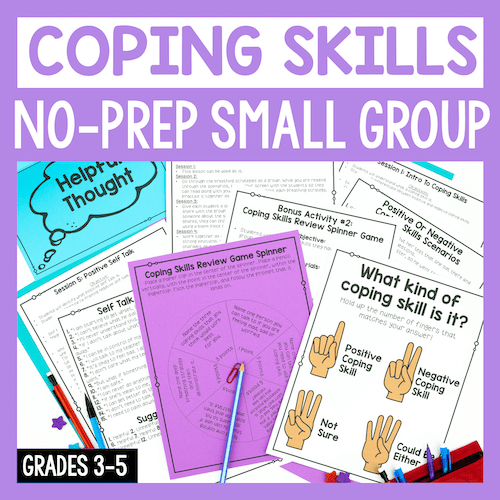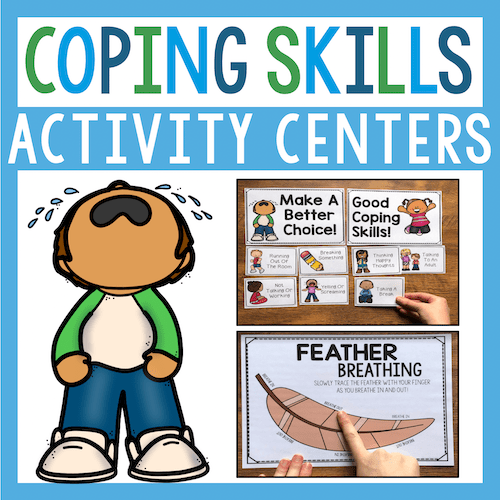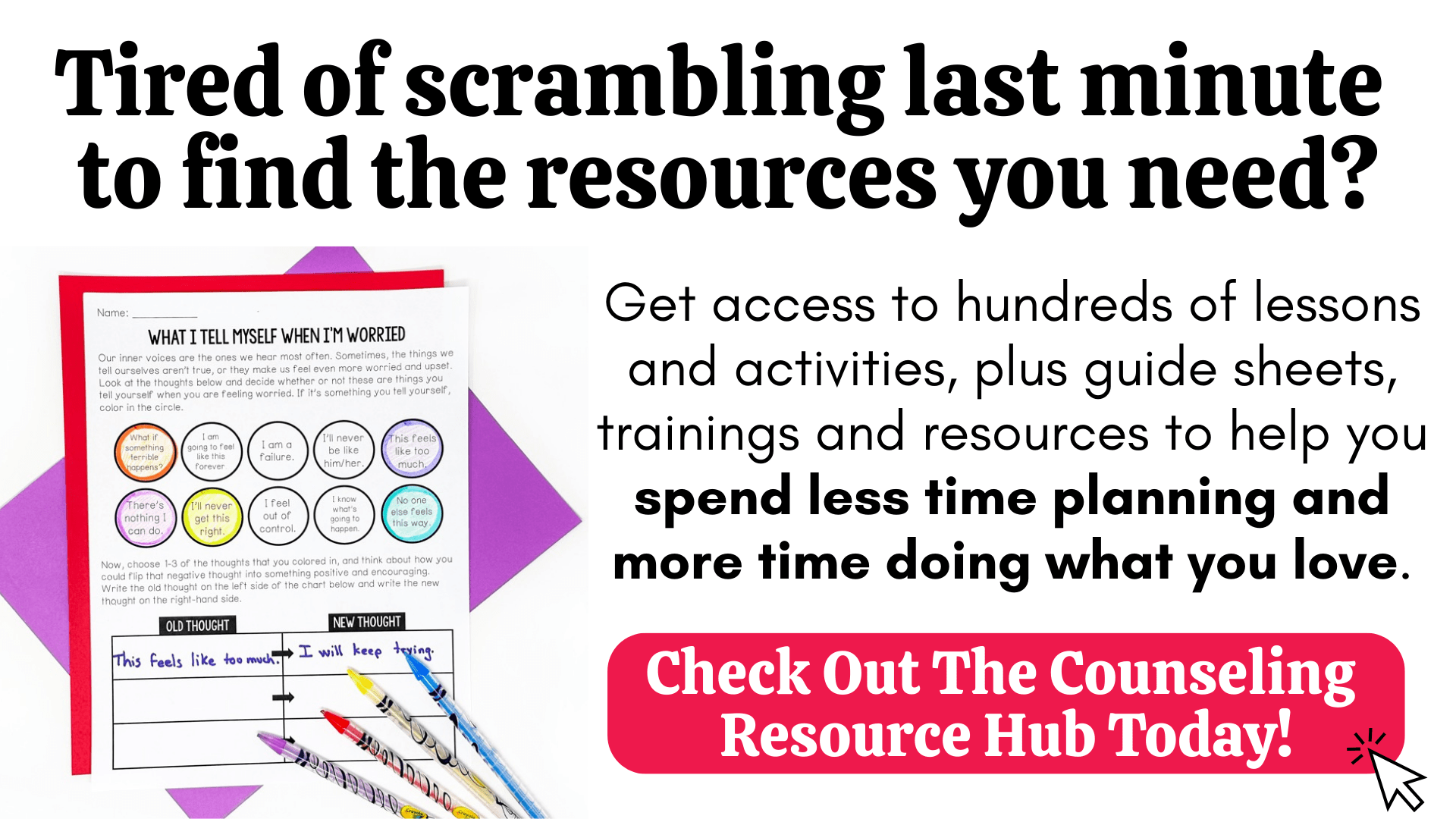4 Must-Have Components Of A Successful Coping Skills Group
Planning school counseling small groups can be challenging. It’s hard to know what to include, and what NOT to include, in the few sessions you have with the students. It’s important to meet the specific needs of the students in the group, yet you also want to make sure to cover the key concepts.
There have certainly been a few times when it felt like trial and error when planning groups, especially when it comes to coping skills. Coping skills small groups are SO important and helpful, but the topic has always seemed so broad. It left me with the question “How do I make sure I cover the essentials while still being able to adapt to my group’s specific needs?”
I know I’m not alone in this.
That’s why I wanted to share ideas for your next coping skills small group to make planning easier. These 4 components are pretty broad, but give you the freedom to make it your own without sacrificing the key concepts your students need to learn. They will allow your students to understand what coping skills are, why they’re important and how they can use the strategies they’ve learned in real life.
1. Give Clear Definitions
This activity is in the first session of my NO PREP coping skills small group.
I’ll never forget the time I ended a 30 minute lesson and then realized the kids had no idea what I was talking about. I kept using a specific term, assuming they knew what it meant, when in reality they didn’t. Everyone was too nervous to ask about it, so I continued on for 30 minutes, confusing my students along the way. I felt like the whole lesson was a fail.
Don’t let the same happen to you when it comes to coping skills.
The term “coping skills” is such a common phrase for people in the counseling/mental health field. But, we can’t assume that kids know what we’re talking about.
That’s why a crucial part of the first lesson in your coping skills small group is actually defining what a coping skill is.
I begin by defining a coping skill as “the way that we handle the feelings or emotions we have.” Then, I go into explaining the difference between a positive coping skill and a negative coping skill. I tell students a negative coping skill is a way to handle our feelings that is unsafe, harmful or doesn’t help us feel any better, while a positive coping skill is safe, not harmful and helps us feel better.
Giving these clear definitions of what a coping skill is and the difference between positive and negative coping skills will give your students the base knowledge they need for the rest of the sessions in the small group.
2. Talk about why Positive Coping Skills Matter
Another key conversation you need to have in your coping skills small group is about why positive coping skills are important. Kids learn best when they understand WHY they are learning something. Don’t believe me? Think about how many people actually try their best to learn trigonometry- I know I didn’t. I didn’t want to put effort into something that I didn’t think would be useful to me.
Of course, coping skills are way different than trigonometry, and also more useful (don’t tell the math people I said that…). Using positive coping skills has many benefits for everyone, and we need to make sure our kids know that!
For example:
We feel better when we are calm.
We can think more clearly when we are calm.
We make better decisions when we are calm.
We might not get in trouble as much when we are calm.
To follow up that conversation, you can ask students to identify how their individual life would be better if they handled their emotions in a more healthy way. This allows students to see that using positive coping skills actually matters in their lives. When they understand the importance, they’ll be more willing to put in the effort to learn about, and practice, their coping strategies.
3. Introduce Different Types Of Coping Skills
This poster that explains physical coping skills can be found in my Free Resource Library.
Of course no coping skills small group would be complete without helping students identify different coping skills they can use.
It’s likely that kids will be coming to you with different types of coping skills, and different amounts, in their coping skills toolboxes. Your goal during this part of the small group is to give students as many coping skills options as possible that they’ll be able to use in real life scenarios.
Teaching about different types of coping skills is important because it gives students many choices to choose from, plus what works for one person might not work for another. For example, my husband goes into the garage and power lifts when he feels upset and that would DEFINITELY not work for me!
Some different types of coping skills I like to cover with students include:
Deep breathing exercises
Expressive coping skills like talking or writing about your feelings
Positive Self Talk
Physical Coping Skills
Interested in learning more about different types of coping skills? Click here to read about 6 types of coping skills to teach your students!
4. Help Students Make a Plan
It’s important to talk about why coping skills are important. However, we also need to explicitly teach students how and when they can use the strategies they have learned. Helping students make a plan for using their new strategies is an impactful activity to use as you close out your coping skills small group.
Here are a few ways to help students make a coping skills plan:
A situation-based plan: In this plan, students will think about different situations that might make them feel upset, frustrated, or anxious. Then, they will identify specific coping skills they can use in those situations. The situations can be hypothetical, or things they have experienced in the past.
A coping skills based plan: In this plan, students will look at all of the coping skills they have learned and choose the ones that will work best for them. I usually encourage students to choose a few strategies from each coping skills category we’ve talked about. This ensures that they’ll have a variety of coping skills they can use in different situations.
No matter how you do it, helping students set up a clear plan of how they will use the strategies they have learned will lead to success as your small group time ends.
Coping skills small groups provide a great opportunity to help students identify positive ways they can handle their emotions. With these 4 simple activities, your next small group is sure to be engaging and effective!
If you’re running a coping skills small group but are tired of the “trial and error”, or just don’t have time to plan, grab my 6 session, no-prep coping skills small group that I’ve already created for you!
It has 6 no-prep lessons that cover the topics from above, as well as 2 bonus activities and a self-assessment for data collection. There are also modifications for social distancing and virtual lessons, for each lesson and activity. This small group plan is a great way to make sure your students are receiving quality instruction without sacrificing any planning time!










